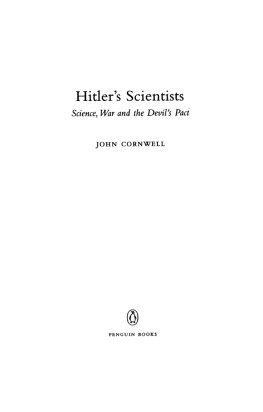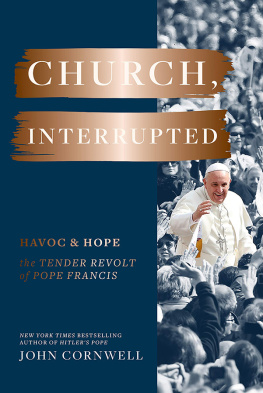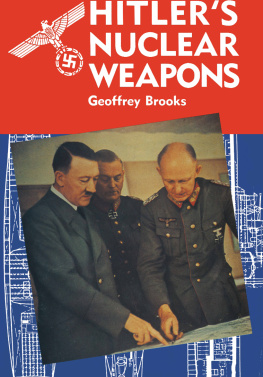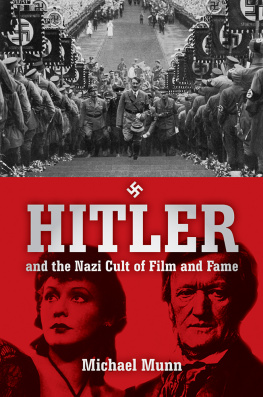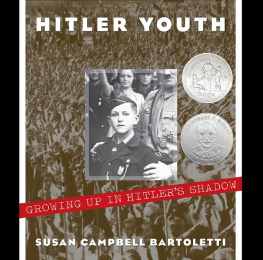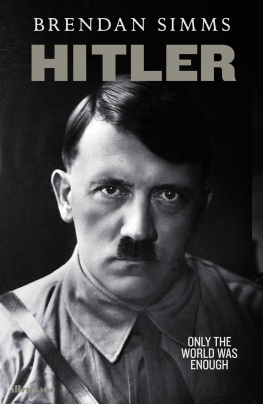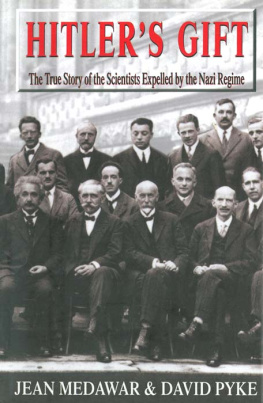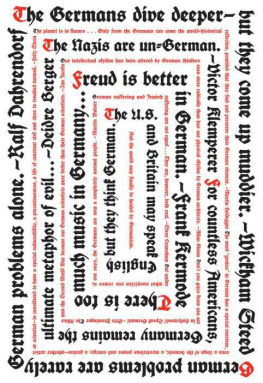Praise for Hitlers Scientists
John Cornwell tears the mask off the myth of the German berscientist. The author does a fine job of focusing on the critical effects that radar, codes, rocket technology and nuclear physics had on both sides of World War II. He also meticulously charts how German research and weapons production became more helter-skelter as the economy buckled, the tide of war turned against the Axis powers, slave labor replaced skilled workmanship and Hitlers orders grew more deranged.
Houston Chronicle
The time is right for this book. Over the past thirty years, historians have unearthed new material and provided fresh interpretations on topics such as Fritz Haberchemical warfare pioneer, Nobel prizewinner and Jewracial hygiene, medicine, physics, the German atomic bomb, rocket science and the leading German scientific institution, the Kaiser Wilhelm Society. But this is the first book to pull these themes together. Cornwell has written an engaging synthesis of the original research: articulate and intelligent, with an eye for telling detail or anecdote. His lively account is also a damning indictment.
Nature
The great merit of Cornwells book is to point out the individual responsibility of scientists for the use that may be made by governments of their work.
The Nation
[Cornwells] insights are as unsettling as they are revelatory. Cornwell presents compelling, detailed life stories of several German scientists, juxtaposing their accomplishments against the political and social turmoil of two world wars, anti-Semitism, Adolf Hitler and the Nazis.
Milwaukee Journal Sentinel
Cornwells previous book, Hitlers Pope, attracted significant controversy. His latest work raises questions about the relationship between scientific progress and warfare that suggest uncomfortable parallels between the past and present. A polemic but a timely one appropriate for audiences beyond war and science buffs.
Booklist
The books broadness dilutes the indictment against any single scientist [but] the broad indictment is no less damning as a result. A noble effort to seek the truth.
San Jose Mercury News
PENGUIN BOOKS
HITLERS SCIENTISTS
John Cornwell, the prizewinning author and journalist, is in the department of history and philosophy of science at Cambridge University. He is a regular feature writer on science at the Sunday Times Magazine (London) and New Scientist and author and editor of four books on science, in addition to the New York Times bestseller Hitlers Pope. He lives in England.
Hitlers Scientists
Science, War and the Devils Pact
JOHN CORNWELL

PENGUIN BOOKS
PENGUIN COMPASS
Published by the Penguin Group
Penguin Group (USA) Inc., 375 Hudson Street, New York, New York 10014, U.S.A. Penguin Group (Canada), 90 Eglinton Avenue East, Suite 700, Toronto, Ontario, Canada M4P 2Y3 (a division of Pearson Penguin Canada Inc.) Penguin Books Ltd, 80 Strand, London WC2R 0RL, England Penguin Ireland, 25 St Stephens Green, Dublin 2, Ireland (a division of Penguin Books Ltd) Penguin Group (Australia), 250 Camberwell Road, Camberwell, Victoria 3124, Australia (a division of Pearson Australia Group Pty Ltd) Penguin Books India Pvt Ltd, 11 Community Centre, Panchsheel Park, New Delhi - 110 017, India Penguin Group (NZ), 67 Apollo Drive, Rosedale, North Shore 0632, New Zealand (a division of Pearson New Zealand Ltd) Penguin Books (South Africa) (Pty) Ltd, 24 Sturdee Avenue, Rosebank, Johannesburg 2196, South Africa
Penguin Books Ltd, Registered Offices: 80 Strand, London WC2R 0RL, England
First published in the United States of America by Viking Penguin,
a member of Penguin Group (USA) Inc. 2003
Published in Penguin Books 2004
13 15 17 19 20 18 16 14 12
Copyright John Cornwell, 2003
All rights reserved
THE LIBRARY OF CONGRESS HAS CATALOGED THE HARDCOVER EDITION AS FOLLOWS:
Cornwell, John 1940
Hitlers scientists : science, war, and the devils pact / John Cornwell.
p. cm.
Includes bibliographical references and index.
ISBN: 978-1-101-64015-9
1. Science and stateGermanyHistory20th century.
2. World War, 1939-1945ScienceGermany. I. Title.
Q127.G3C67 2003 2003057650
Printed in the United States of America
Set in Bembo
Except in the United States of America, this book is sold subject to the condition that it shall not, by way of trade or otherwise, be lent, resold, hired out, or otherwise circulated without the publishers prior consent in any form of binding or cover other than that in which it is published and without a similar condition including this condition being imposed on the subsequent purchaser.
The scanning, uploading and distribution of this book via the Internet or via any other means without the permission of the publisher is illegal and punishable by law. Please purchase only authorized electronic editions, and do not participate in or encourage electronic piracy of copyrighted materials. Your support of the authors rights is appreciated.
In memory of Max Perutz
List of Illustrations
The fountains of the Chteau dEau with the Palais dElectricit at the Paris International Exhibition.
Max Planck.
Fritz Haber inspecting poison gas canisters in World War I.
Fritz Haber.
Clara Immerwahr.
Kaiser Wilhelm II opening a Kaiser Wilhelm Institute in Berlin.
Philipp Lenard.
Lise Meitner and Otto Hahn.
Johannes Stark.
Enrico Fermi, Werner Heisenberg and Wolfgang Pauli.
Copenhagen Physics Conference, June 1936.
Professor Oberth with a group of his staff.
Adolf Hitler inspects the first German U-boats in Kiel.
Hitler and his Deputy Rudolf Hess.
Bernhard Rust.
Hitler at the 1935 Berlin Automobile Exhibition.
Albert Einstein and Leo Szilard.
Frdric Joliot-Curie.
Otto Frisch and Rudolph Peierls.
Albert Speer and Josef Goebbels.
Albert Speer and Hitler.
Measuring the features of a German.
German Mk 6 Tiger Tank.
Winston Churchill and Frederick Lindemann.
German signal troops sending coded messages on an Enigma machine.
V1 rocket over London.
V2 rocket.
Messerschmitt Me-262.
Experiments on a prisoner at Dachau.
Primo Levi.
Heisenbergs reactor at Haigerloch.
Farm Hall.
Max von Laue.
Carl Friedrich von Weizscker.
Paul Harteck.
Fat Man nuclear weapon.
General Groves and J. Robert Oppenheimer.
Wernher von Braun surrenders to US counterintelligence personnel.
President John F. Kennedy and Wernher von Braun.
Photographic acknowledgements
1: Hulton Archive/Getty Images; 2, 3, 4, 5, 6, 8: Max Planck Archive, Berlin-Dahlem; 9: photo by A. B. Lagrelius & Westphal, courtesy AIP Emilio Segr Visual Archives, Weber Collection; 10: photo by F. D. Rasetti, courtesy AIP Emilio Segr Visual Archives; 11: Niels Bohr Archive, Copenhagen; 12, 28: Smithsonian Institution; 13, 14, 16: Christopher Hurndall; 15, 37: Bettman/ CORBIS; 17: Time Pix/Getty Images; 18: Magnum; 19: UK Atomic Energy Authority; 20: Bundesarchiv Koblenz; 21: Hulton Archive/Getty Images; 22: Hulton-Deutsch Collection/CORBIS; 23, 24, 26, 27, 29, 38: Imperial War Museum; 25: CORBIS; 30: Dachau Museum; 31: Gente; 32: AIP Emilio Segr Visual Archives, Goudsmit Collection; 39, 40: NASA.
Every effort has been made to contact all copyright holders. The publishers will be glad to make good in all future editions any errors or omissions brought to their attention.
Acknowledgements
Drawing together a history of science in Germany in the first half of the twentieth century with special reference to the period of the Third Reich involves acquaintance with a wide circuit of scholarship over the past three decades. I have profited from the work of many historians, but especially from the published work of Jeremy Bernstein, Alan Beyerchen, Michael Burleigh, David Cassidy, Ute Deichmann, Helge Kragh, Christie Macrakis, Benno Mller-Hill, Michael C. Neufeld, Thomas Powers, Robert Proctor, Monika Renneberg, Richard Rhodes, Paul Lawrence Rose, Ruth Sime, Mark Walker and Paul Weindling. I also owe a special debt of gratitude to those who attended the
Next page
